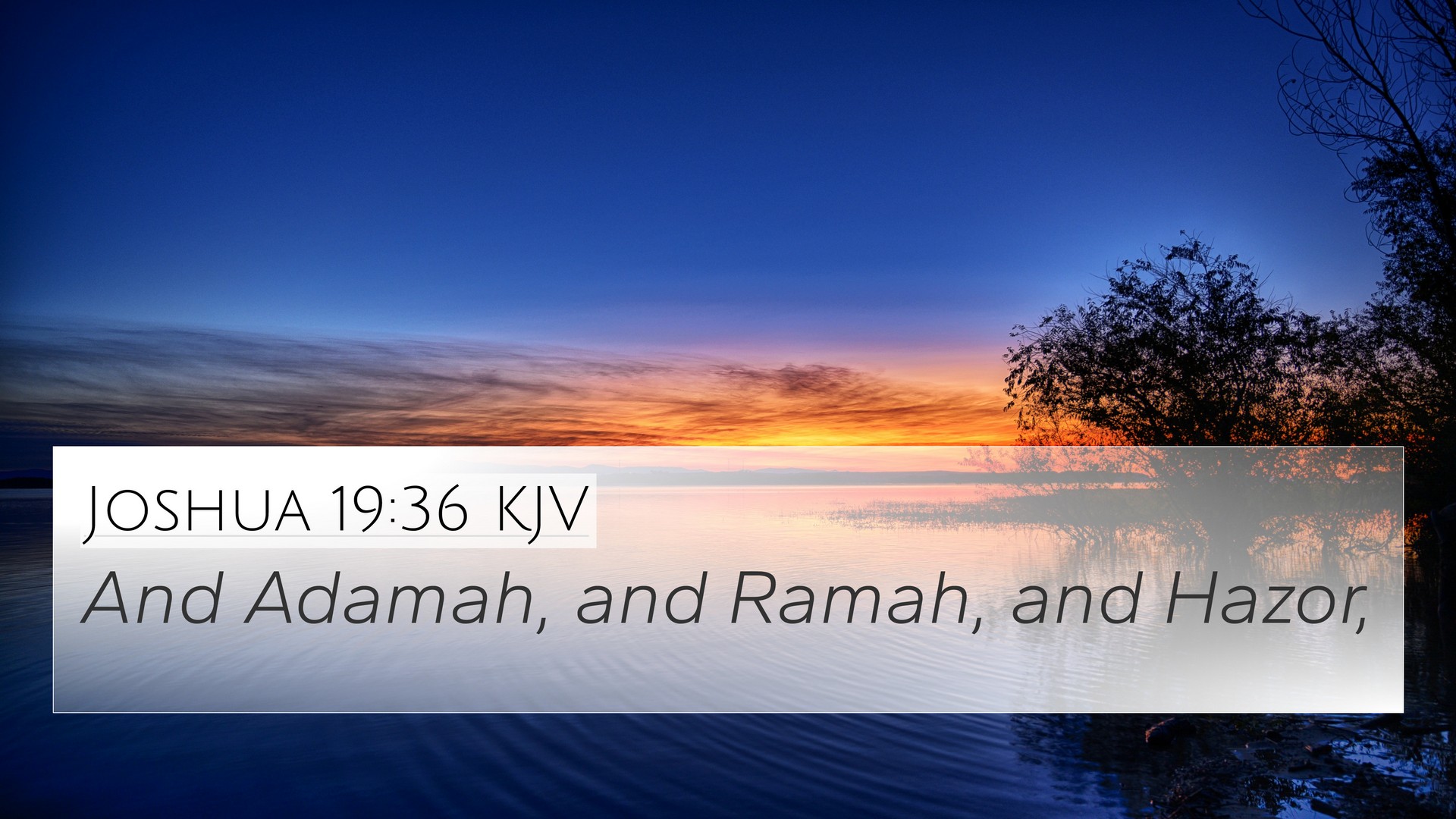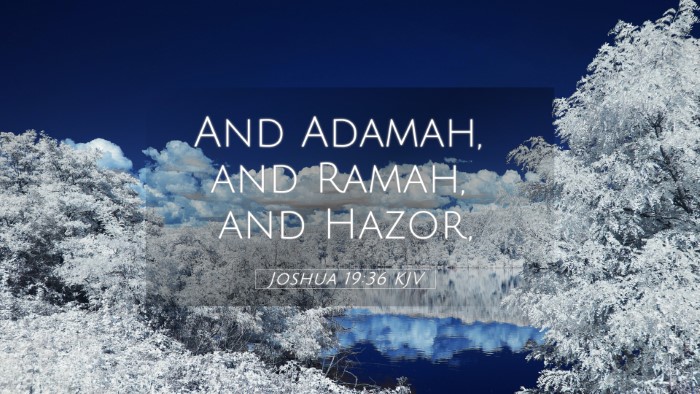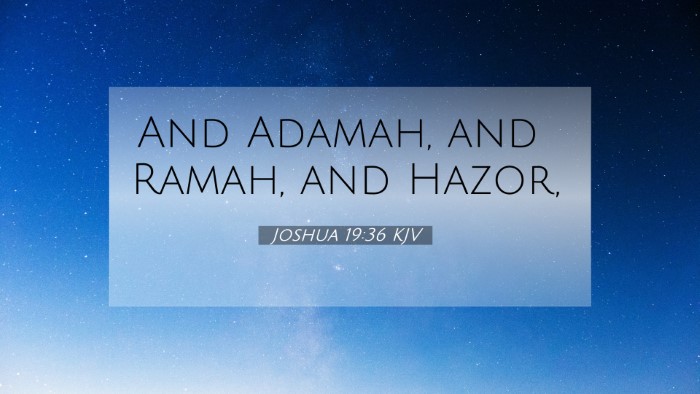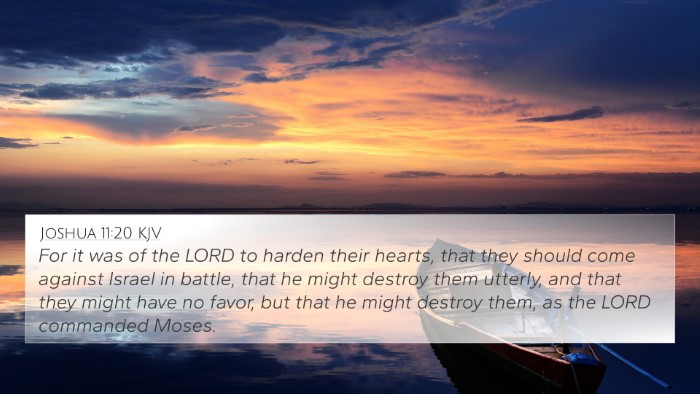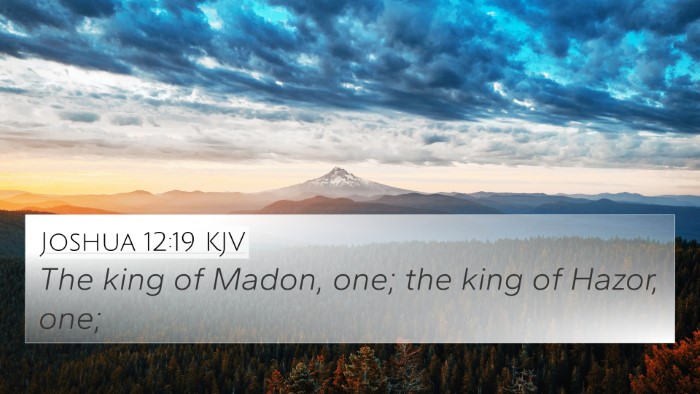Understanding Joshua 19:36
Bible Verse: Joshua 19:36
Verse Text: "And the city of Mahalah, and the city of Bileam; two cities." (KJV)
This particular verse pertains to the allotment of land to the tribe of Naphtali, detailing specific cities that were designated within their territory.
Summary of Insights
Contextual Overview: Joshua 19 highlights the distribution of land among the tribes of Israel after their conquest of Canaan. Verse 36 specifically names two cities within the allotment of Naphtali, Mahalah and Bileam, which were crucial for the tribe's settlement and development.
Interpretation from Commentaries
-
Matthew Henry: He emphasizes the importance of naming places as it signifies heritage and the fulfillment of God's promise to the Israelites. The names of cities represent both physical locations and spiritual significance as the people of God settle in the land of their inheritance.
-
Albert Barnes: Barnes notes that the specification of cities aids in visualizing the territory assigned to each tribe. The mention of Mahalah and Bileam reflects both the historical and topographical realities of the region, affirming God's careful provision for His people.
-
Adam Clarke: Clarke interprets the cities as symbols of refuge and safety for the tribe. The allocation of these locations underscores the sense of community and the necessity for places of gather, enhancing the tribal identity of Naphtali.
Bible Cross-References
To deepen your understanding of Joshua 19:36, consider these related verses:
- Genesis 49:21 - "Naphtali is a deer let loose; he uses beautiful words."
- Deuteronomy 33:23 - "Of Naphtali he said, 'O Naphtali, satisfied with favor, and full of the blessing of the Lord, possess the west and the south.' "
- Joshua 19:32-34 - Outlines the broader allocation for the tribe of Naphtali.
- Judges 4:6 - "She sent and summoned Barak the son of Abinoam from KedeshNaphtali..." highlights the active role of the Naphtali tribe in battles.
- 1 Chronicles 12:34 - Mentions the warriors of Naphtali as skilled men, emphasizing their role in Israel's history.
- Matthew 4:13-16 - "And leaving Nazareth he went and lived in Capernaum by the sea, in the territory of Zebulun and Naphtali..." linking New Testament geography to Old Testament tribes.
- Luke 2:36 - "And there was a prophetess, Anna, the daughter of Phanuel, of the tribe of Asher..." noting the regional background of other tribes which gives context to Naphtali’s placement.
Connections Between Bible Verses
The thematic links between Joshua 19:36 and other scriptures can be explored through the lens of biblical heritage, community, and the fulfillment of God’s promises. In doing so, we gain insights into how collective tribal history informs our understanding of God’s overarching narrative.
-
Heritage and Land: The cities listed serve as a reminder of the covenantal promises made to the ancestors of Israel (Genesis 12:7).
-
Communal Identity: Each tribe carries its identity, and the cities are part of their communal memories, as seen in passages like 1 Chronicles 12 that highlight tribal involvement in Israel's history.
-
Spiritual Legacy: The geographical mention in Joshua parallels the spiritual lessons derived from the tribes in the New Testament, such as in Matthew 4:13-16, where Jesus’ ministry intersects with historic tribal regions.
Tools for Bible Cross-Referencing
For effective study of cross-references in the Bible, one can utilize various tools:
- Using a Bible Concordance can offer valuable insights into themes and references.
- A Bible Cross-reference Guide can streamline the process of finding thematic connections.
- Bible study tools like commentaries and dictionaries can provide deeper contextual understanding as seen with Matthew Henry’s and Albert Barnes’ insights.
Conclusion
Joshua 19:36 serves as a structural pillar in understanding the allotment of land among the tribes of Israel. Through cross-referencing related scriptures, one can gain a deeper appreciation for the inherited land, the identity of tribes, and the fulfillment of God's promises in both the Old and New Testaments. This approach of linking scriptures facilitates thematic Bible verse connections that enhance one's study and understanding of the Bible.
